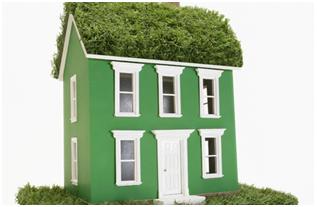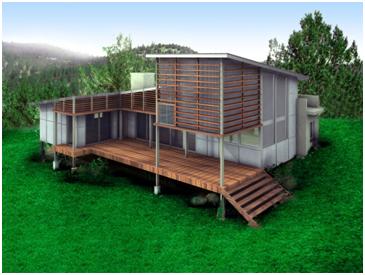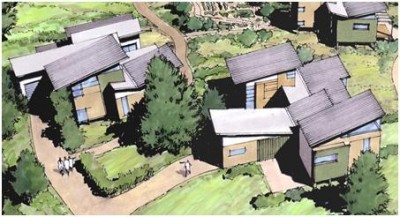
The building and construction sector is a major source of environmental degradation. Its geographical spread, rapid growth rate, and the long lives of the structures being built the lead to widespread impacts affecting several generations. This makes this sector a hot spot requiring careful analysis and begins intervention. The dynamics of current socio-economic systems ensure that the sector will continue to grow at a rapid rate. The development pathways of most Asian countries are symptomatic of these trends.
The application of eco-housing has the potential to reverse these trends. A central goal of this evolving concept is to achieve comfortable and healthy habitats at affordable costs, through low impact methods, consuming fewer resources than a standard habitat, and using environmentally friendly materials and products.
It also sets out to be a net producer of environmental and social goods by imitating the self-sustaining, cyclic processes of nature. In practice, this will involve minimizing resource intensity leading to “dematerialization” and to “rematerialize” by using the bio-climatic features of the site to create environmental and social goods. Bio-climatic design principles and life cycle approach aids in this process. Eco-housing re-visits sustainable traditional architectural practices, explore the possibilities of modern technology and advocates the use of renewable resources.
This wide spectrum of objectives needs to be integrated across several mature disciplines and design objectives. Environment-friendly site planning, appropriate choices of materials and products, sustainable use of energy and water, provision of clean water, indoor environment quality and sanitation, wastewater and solid waste management, and proper operation and maintenance, are key areas of application of the concept. This calls for an effective interdisciplinary team with good project management skills. Integrated design and project management software could help in this process.
The need for Eco-Housing
Eco-housing has caught the attention of decision-makers in Asia, but a lack of real examples has prevented its adoption on a larger scale. To meet this need, UNEP and UN-HABITAT joined hands in 2004, to promote and demonstrate eco- housing as a key preventive measure in the Asia-Pacific region. They facilitated the establishment of a Regional Expert Group on eco-housing, which recommended that the concept be taken forward through a project addressing four key areas: knowledge building, educational initiatives, and networking and demonstration projects. Design Guidelines were prepared to facilitate the demonstration projects and for dissemination. This publication is a compilation of these guidelines and the experience in implementing them.
The guidelines are expected to build awareness and capacity in the Asia Pacific region. It also would challenge practitioners to take up more ambitious targets. Apart from the guidelines, this publication also introduces the readers to key concepts, technologies, and other useful resources.

The need for eco-housing Civilizations is often known by their architectural legacy. We discover in them the accumulated wisdom of thousands of years, based on a deep understanding of sustainable patterns of living. These priceless legacies are vanishing under the assault of the technologies and fashions let loose by the Industrial Revolution.
The rapid growth of the global economy and the rising trends in population and urbanization has raised concrete jungles over once verdant landscapes, threatening flora and fauna. Social changes that accompany affluence such as the splitting up of the extended families into nuclear families and the demand for larger houses have added momentum to the increasing demand for housing. Builtup land increased from 0.23 billion global ha in 1961 to 0.44 billion global in 2001; an increase of 91.3%. (WWF, 2004)
The informal sector is playing a major part in supplying the huge demand for housing. This often includes self-built houses, many of them illegal and mostly lacking infrastructure (UNEP DTIE, 2003. p.5) a combination of increasing quantities and decreasing qualities is straining the carrying capacity of the global ecosystem. Taking into account its entire lifespan, the built environment worldwide is currently responsible for up to 25 to 40% of energy use, 30 to 40% of solid waste generation, and 30 to 40% of global greenhouse gas emissions.
On the positive side, the building and construction sector have become the engines of economic growth in the modern era. On average, the sector provides 5 to 10% of employment, mostly to unskilled workers, and accounts for 5 to 15% of the national GDP.
Guidelines for Eco-housing
Select an effective, multi-disciplinary design team. The team could include the owner, architects, engineers, and subject-specific experts
Make an assessment of the existing socio-cultural, environmental, and economic conditions of the locality. The project needs to use and maximize the existing potential.
Develop a vision statement. The vision statement should clearly set out the goals, objectives, and processes. It should be based on the site assessment, resource availability, available best practices and technologies, and cost-effectiveness. The project must also identify if the design goals intend to achieve improvements over the conventional standards, e.g., better envelope standards than minimum energy codes, better water efficiency than the national codes. The goals need to be prioritized based on the needs and project constraints, e.g., water quality and conservation may be a priority in tsunami-affected regions.


Anny spent most of her time dwelling on useful things, and she drives all her research visible through her articles. Most of her unique and challenging topics include product reviews and descriptions of eco-friendly products and technologies.